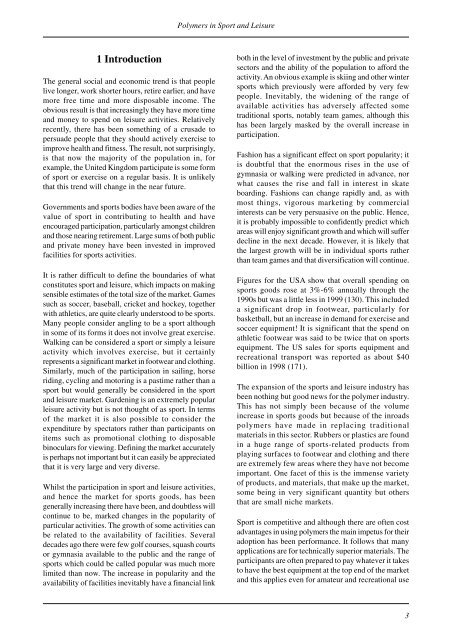Polymers in Sport and Leisure
Polymers in Sport and Leisure
Polymers in Sport and Leisure
Create successful ePaper yourself
Turn your PDF publications into a flip-book with our unique Google optimized e-Paper software.
<strong>Polymers</strong> <strong>in</strong> <strong>Sport</strong> <strong>and</strong> <strong>Leisure</strong><br />
1 Introduction<br />
The general social <strong>and</strong> economic trend is that people<br />
live longer, work shorter hours, retire earlier, <strong>and</strong> have<br />
more free time <strong>and</strong> more disposable <strong>in</strong>come. The<br />
obvious result is that <strong>in</strong>creas<strong>in</strong>gly they have more time<br />
<strong>and</strong> money to spend on leisure activities. Relatively<br />
recently, there has been someth<strong>in</strong>g of a crusade to<br />
persuade people that they should actively exercise to<br />
improve health <strong>and</strong> fitness. The result, not surpris<strong>in</strong>gly,<br />
is that now the majority of the population <strong>in</strong>, for<br />
example, the United K<strong>in</strong>gdom participate is some form<br />
of sport or exercise on a regular basis. It is unlikely<br />
that this trend will change <strong>in</strong> the near future.<br />
Governments <strong>and</strong> sports bodies have been aware of the<br />
value of sport <strong>in</strong> contribut<strong>in</strong>g to health <strong>and</strong> have<br />
encouraged participation, particularly amongst children<br />
<strong>and</strong> those near<strong>in</strong>g retirement. Large sums of both public<br />
<strong>and</strong> private money have been <strong>in</strong>vested <strong>in</strong> improved<br />
facilities for sports activities.<br />
It is rather difficult to def<strong>in</strong>e the boundaries of what<br />
constitutes sport <strong>and</strong> leisure, which impacts on mak<strong>in</strong>g<br />
sensible estimates of the total size of the market. Games<br />
such as soccer, baseball, cricket <strong>and</strong> hockey, together<br />
with athletics, are quite clearly understood to be sports.<br />
Many people consider angl<strong>in</strong>g to be a sport although<br />
<strong>in</strong> some of its forms it does not <strong>in</strong>volve great exercise.<br />
Walk<strong>in</strong>g can be considered a sport or simply a leisure<br />
activity which <strong>in</strong>volves exercise, but it certa<strong>in</strong>ly<br />
represents a significant market <strong>in</strong> footwear <strong>and</strong> cloth<strong>in</strong>g.<br />
Similarly, much of the participation <strong>in</strong> sail<strong>in</strong>g, horse<br />
rid<strong>in</strong>g, cycl<strong>in</strong>g <strong>and</strong> motor<strong>in</strong>g is a pastime rather than a<br />
sport but would generally be considered <strong>in</strong> the sport<br />
<strong>and</strong> leisure market. Garden<strong>in</strong>g is an extremely popular<br />
leisure activity but is not thought of as sport. In terms<br />
of the market it is also possible to consider the<br />
expenditure by spectators rather than participants on<br />
items such as promotional cloth<strong>in</strong>g to disposable<br />
b<strong>in</strong>oculars for view<strong>in</strong>g. Def<strong>in</strong><strong>in</strong>g the market accurately<br />
is perhaps not important but it can easily be appreciated<br />
that it is very large <strong>and</strong> very diverse.<br />
Whilst the participation <strong>in</strong> sport <strong>and</strong> leisure activities,<br />
<strong>and</strong> hence the market for sports goods, has been<br />
generally <strong>in</strong>creas<strong>in</strong>g there have been, <strong>and</strong> doubtless will<br />
cont<strong>in</strong>ue to be, marked changes <strong>in</strong> the popularity of<br />
particular activities. The growth of some activities can<br />
be related to the availability of facilities. Several<br />
decades ago there were few golf courses, squash courts<br />
or gymnasia available to the public <strong>and</strong> the range of<br />
sports which could be called popular was much more<br />
limited than now. The <strong>in</strong>crease <strong>in</strong> popularity <strong>and</strong> the<br />
availability of facilities <strong>in</strong>evitably have a f<strong>in</strong>ancial l<strong>in</strong>k<br />
both <strong>in</strong> the level of <strong>in</strong>vestment by the public <strong>and</strong> private<br />
sectors <strong>and</strong> the ability of the population to afford the<br />
activity. An obvious example is ski<strong>in</strong>g <strong>and</strong> other w<strong>in</strong>ter<br />
sports which previously were afforded by very few<br />
people. Inevitably, the widen<strong>in</strong>g of the range of<br />
available activities has adversely affected some<br />
traditional sports, notably team games, although this<br />
has been largely masked by the overall <strong>in</strong>crease <strong>in</strong><br />
participation.<br />
Fashion has a significant effect on sport popularity; it<br />
is doubtful that the enormous rises <strong>in</strong> the use of<br />
gymnasia or walk<strong>in</strong>g were predicted <strong>in</strong> advance, nor<br />
what causes the rise <strong>and</strong> fall <strong>in</strong> <strong>in</strong>terest <strong>in</strong> skate<br />
board<strong>in</strong>g. Fashions can change rapidly <strong>and</strong>, as with<br />
most th<strong>in</strong>gs, vigorous market<strong>in</strong>g by commercial<br />
<strong>in</strong>terests can be very persuasive on the public. Hence,<br />
it is probably impossible to confidently predict which<br />
areas will enjoy significant growth <strong>and</strong> which will suffer<br />
decl<strong>in</strong>e <strong>in</strong> the next decade. However, it is likely that<br />
the largest growth will be <strong>in</strong> <strong>in</strong>dividual sports rather<br />
than team games <strong>and</strong> that diversification will cont<strong>in</strong>ue.<br />
Figures for the USA show that overall spend<strong>in</strong>g on<br />
sports goods rose at 3%-6% annually through the<br />
1990s but was a little less <strong>in</strong> 1999 (130). This <strong>in</strong>cluded<br />
a significant drop <strong>in</strong> footwear, particularly for<br />
basketball, but an <strong>in</strong>crease <strong>in</strong> dem<strong>and</strong> for exercise <strong>and</strong><br />
soccer equipment! It is significant that the spend on<br />
athletic footwear was said to be twice that on sports<br />
equipment. The US sales for sports equipment <strong>and</strong><br />
recreational transport was reported as about $40<br />
billion <strong>in</strong> 1998 (171).<br />
The expansion of the sports <strong>and</strong> leisure <strong>in</strong>dustry has<br />
been noth<strong>in</strong>g but good news for the polymer <strong>in</strong>dustry.<br />
This has not simply been because of the volume<br />
<strong>in</strong>crease <strong>in</strong> sports goods but because of the <strong>in</strong>roads<br />
polymers have made <strong>in</strong> replac<strong>in</strong>g traditional<br />
materials <strong>in</strong> this sector. Rubbers or plastics are found<br />
<strong>in</strong> a huge range of sports-related products from<br />
play<strong>in</strong>g surfaces to footwear <strong>and</strong> cloth<strong>in</strong>g <strong>and</strong> there<br />
are extremely few areas where they have not become<br />
important. One facet of this is the immense variety<br />
of products, <strong>and</strong> materials, that make up the market,<br />
some be<strong>in</strong>g <strong>in</strong> very significant quantity but others<br />
that are small niche markets.<br />
<strong>Sport</strong> is competitive <strong>and</strong> although there are often cost<br />
advantages <strong>in</strong> us<strong>in</strong>g polymers the ma<strong>in</strong> impetus for their<br />
adoption has been performance. It follows that many<br />
applications are for technically superior materials. The<br />
participants are often prepared to pay whatever it takes<br />
to have the best equipment at the top end of the market<br />
<strong>and</strong> this applies even for amateur <strong>and</strong> recreational use<br />
3










